This Fowl Friday we thought we’d show you how much our hens are making a spectacle of themselves.
This has nothing to do with the lastest craze in poultry fashion though, it’s because some of our girls have aquired the evil habit of feather-picking their flock mates.
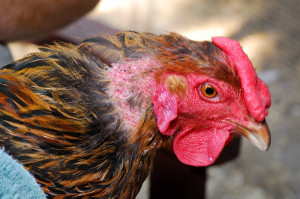
When good hens go bad, they pluck the feathers of their coop mates. This Golden Laced Wyandotte has had the feathers pulled from her neck
Feather picking in poultry flocks can occur for a variety of reasons. It’s part of normal dominance behavior in chickens. Sometimes it can get out of hand when a hen accidentally draws blood on a flock-mate, as bleeding can incite a pecking frenzy. Excessive picking can also be exacerbated by environmental stressors. This could be nutritional stress, secondary to inadequate feed levels, or nutrient deficiencies. Climatic stress due to excessive heat, or cold. Stress due to overcrowding, mixing different breeds, colors, or sizes of hens. Use of excessive artificial lighting programs can also lead to an increase in feather picking. Occasional picking may be more of an aesthetic problem, but this behavior can, in severe cases, lead to significant injury, and even death.
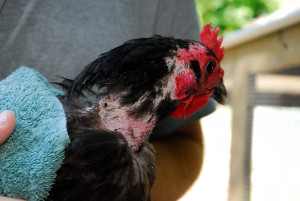
Although the feathers would continually try to regrow, the pluckers in the coop would rip them out before they filled back in
Hens have a nasty habit of pecking at anything new, or different, just ask our rooster Frodo, who lost his tail to one of our older hens last year.
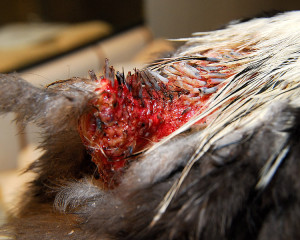
Our rooster Frodo lost his tail to one of our old hens, who turned on him (don't worry Frodo's tail did grow back)
Looking different, as Frodo will attest to, can cause you to be singled out in the flock.
The fact that picking may be more likely to occur in flocks composed of mixed colors and sizes, seems to certainly be proving true for this flock. If you followed the trials and tribulations of our rooster Frodo last year, you’ll recognize that this ‘being different gets you picked on’ theme has come up more than once. As such we’re determined that any future flocks at Curbstone Valley will be single breed/size/color flocks only.
Looking different isn’t the only cause of feather loss though. If you followed some of the drama last year regarding our rooster Siegfried, and his girls, you might recall that he was rather hard on his hens, as is typical of roosters that live full time with the girls. By the time Siegfried was ousted from the coop, his girls were an absolute mess, and some had sustained injuries from his excessive advances.
In hindsight, we suspect that this feather-picking behavior began back when Siegfried was still with the flock, with one of our Delaware hens occasionally picking on his tail feathers.
From there, this behavior then transferred to picking on the exposed skin of some of the other hens where Siegfried had accidentally pulled feathers out during mating.
We hoped soon after Siegfried was gone that the girl’s feathers would fill back in, and for a time it seemed they were starting to, but by early summer this year the feather loss situation began to escalate. This time though we couldn’t blame the rooster.
Through close observation during the day, and paying attention to who was roosting next to whom at night, we identified two Delawares as the most likely perpetrators. There was also a Golden Laced Wyandotte who, although we had never seen her pick on other hens, was very consipicous in that she was the only hen in the entire flock who still had all of her feathers intact.
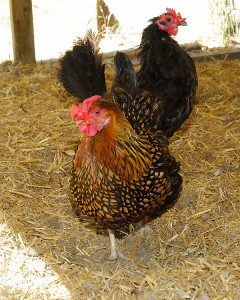
It seemed suspicious that this Wyandotte hen still had her full complement of feathers, when all our Australorps looked moth-eaten!
This is the same Wyandotte I lost a mole to on my arm last year. She has a history of being a witch aggressive.
Feather picking often starts with one hen, but it is also a learned behavior, and other members of the flock can easily pick up this bad habit, so we weren’t convinced this Wyandotte was the only source of the problem. Eventually we narrowed it down to two Delawares, one Wyandotte, and a Partridge Plymouth Rock hen as the principle aggressors. They were then removed from the flock, and placed in the poultry penitentiary (our portable chicken tractor), to see if this halted the feather loss. It helped, but it certainly didn’t solve the problem.
Feather picking is not an uncommon consequence of confinement. Even though our girls have a large protected outdoor run, which we expanded last year, and we do range the hens, under supervision, they aren’t ranged all day, and not always every day, as our bobcats, and coyotes, prevent us from leaving the girls out unattended. It would only take one day, one bobcat, one coyote pack, and the flock here could be completely wiped out in an instant.
It’s a balance between protecting the hens, and allowing them the freedom to roam.
This is not an occasional threat either. Almost every day we see either ‘Bob’, or his coyote friends. I’m not joking, Bob is now so used to being here that he makes himself quite at home!
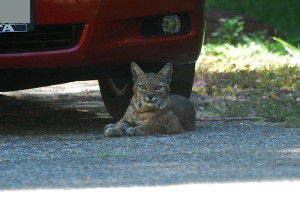
This fat, lazy bobcat, spends more time harassing the poultry, than he does anything else. Of course, it's important to rest up before terrorizing your next potential meal.
As leaving the girls on range full time isn’t an option, we decided to try to make their run a little more exciting, give the girls more to do than pick on each other. The girls always get daily fresh assorted produce in addtion to their feed, but to mix things up a little we tried hanging heads of cabbage in the run (which actually scared them senseless), and hiding treats in areas throughout the run, which they enjoy, in addition to trying to let them range more frequently. Unfortunately, removing the presumed perpetrators, and jazzing up the coop wasn’t enough, and seemed to have very little effect on the overall level of picking. We were back to square one.
As such we needed to find an alternate method of decreasing the picking behavior. Out of exasperation I was tempted to start culling the offenders. I know it sounds drastic, but it’s better than the behavior escalating into full-blown cannibalism. However, the girls are excellent layers, and we really didn’t want to go there until we’d tried everything else. So, in a final attempt to address the problem flock-wide, and permit our perpetrators to rejoin the main flock, for their own safety, as a last resort we decided to try using ‘pinless peepers’.
These plastic slip-on spectacles prevent the hens from seeing directly in front of them. It’s a little like using blinders on a cart-horse. As the hens have to turn their head to the side to see something in front of them, it means they can’t easily peck an object (particularly another hen) directly in front of them.
These particular ‘peepers’ are pinless. They have two plastic prongs that rest in the nostrils of the hen. There are peepers with actual sharp metal pins, that are designed to pierce through the nasal septum to secure them, but most consider them to be inhumane, myself included, and are prohibited from use in some areas on welfare grounds. These pinless peepers however are painless, and just clip into the nostrils (note however, some countries still ban the use of pinless peepers).
We soaked the peepers in very hot water for a few minutes before applying them, to make the plastic more pliable.
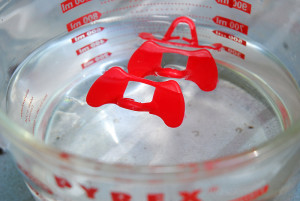
Soaking the pinless peepers before applying them makes the plastic more pliable, and the peepers much easier to install
We chose to put the peepers on all of the hens. If you read some of our Fowl Friday posts last year you’re well aware that anything different in the coop can be the catalyst for a hen (or rooster) for getting picked on. We felt that if everyone had peepers on, then everyone would look the same, and there’d be no one hen that would stand out in the flock. We also still weren’t sure just how many in the flock were responsible for the feather picking.
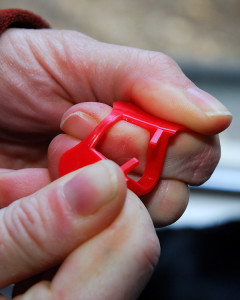
The pinless peepers are stretched apart, positioned over the beak, and the two prongs rest inside each nostril
So, first thing one Saturday morning we retrieved each hen, one by one, from the coop. My assistant, Mr. Curbstone, sat down in a garden chair, and restrained each hen gently in a towel, just enough to lightly restrain her wings. He then stretched out the hen’s neck, steadying her head, as I stretched the peepers open, and popped them quickly over the upper beak, seating it securely in each side of her nostril.
These pinless peepers were tremendously easy to install, and after the first couple, we became very efficient at it. The trick is to get them on quickly, and accurately, with no messing about, before the hen even realizes what you’ve done. There are special pliers you can purchase to install them, but honestly, we didn’t find them necessary.
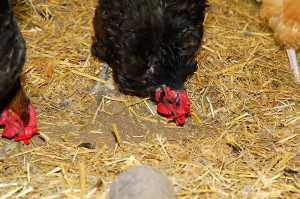
As we set each hen down, she'd scratch at her nose for a few seconds, and then immediately go back to foraging around. They just don't notice them.
Each hen, with her new bling, was then turned loose in the run, and by the time the next hen was fitted with her spectacles, the previous hen had forgotten all about it, and was going about her business.
In 24 hours we only had one pair fall off, and that was probably my own fault. We had one very squiggly Australorp who just wouldn’t hold still during her fitting, and I probably didn’t quite get it seated securely on both sides. However, we refitted her peepers in the morning without a fuss, and that was three weeks ago, and not a single hen has lost a pair since!
The good news is these pinless peepers seem to be having the desired effect of decreasing the incidence of feather picking within the flock. So much so that for the first time in months our most heavily picked on girls are finally getting a set of new feathers!
This was Sam right after we fitted her peepers…
…and this was Sam less than two weeks later.
This Delaware had sustained substantial injuries from picking, and even she is growing in a whole new set of feathers. Notice all the new pin feathers around her wings…

This Delaware still has a hint of Blue-Kote around her elbow where the other hens pecked her raw, but she's now growing in lots of new feathers
…even down the backs of her legs!
There are caveats with using pinless peepers. Obviously you have to ensure they can’t get caught on something. We watched the hens for some time that morning to be sure everyone was settled and happy, and that there was no risk of them catching the peepers in the hardware cloth on the run. One thing we did notice during the day was that some of our hens were reluctant to use their hanging feeder once they were fitted with their new spectacles. As the trough at the base of the feeder is very narrow, they seemed to resist pecking the food, perhaps because they have to turn their head to see the food, but then can’t see it to eat it. To ensure that everyone has access to food, we left the hanging feeder for those that were using it, but also now keep a wide bowl with feed available at all times, which most of them seem more willing to use.
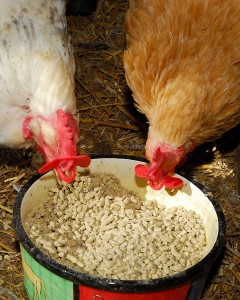
Some of hens refused to use their conventional feeder after being fitted with peepers, so we offer feed in shallow containers for those hens
As our predators here are unrelenting, and it’s unrealistic to range our hens full time, our goal is to relocate our turkeys over winter to a different area of the farm, and expand the outdoor enclosure for the hens, again, making it even larger, in the hopes it will help to squash this behavior.
In the meantime, we’re hopeful that these peepers will continue to help the girls from being picked on, and that the rest of their feathers will fill back in. The peepers might look a bit silly, but so far they seem to be doing the trick!
“Jeepers Creepers, Where’d You Get Those Peepers?
Jeeper’s Creepers, Where’d You Get Those Eyes?”
—————-
Pinless Peepers are available from a number of suppliers online:
National Band and Tag Co.
Kuhl Corporation
Randall Burkey
EggCartons.com

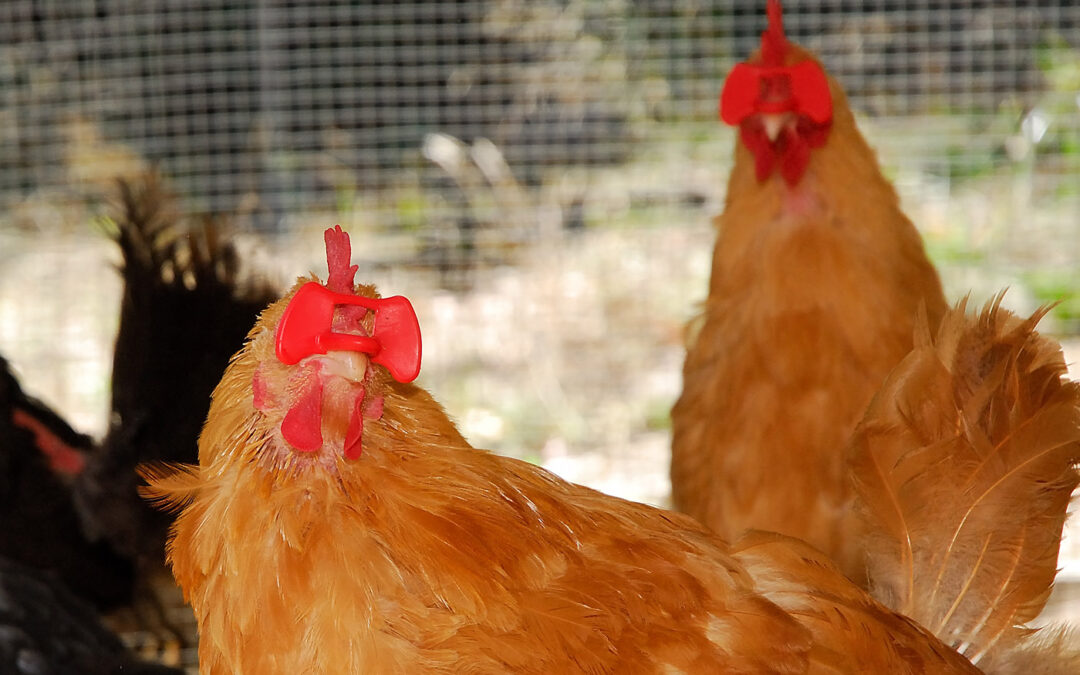
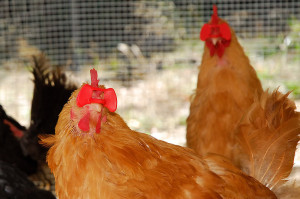
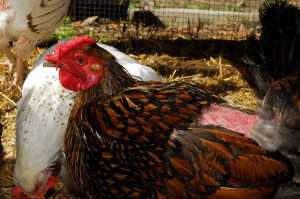

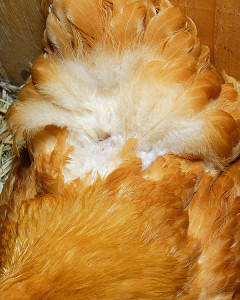
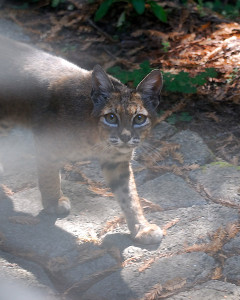
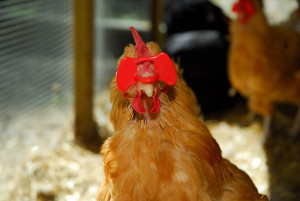
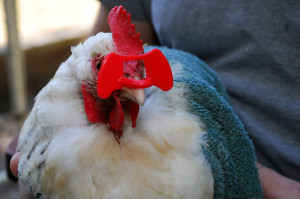
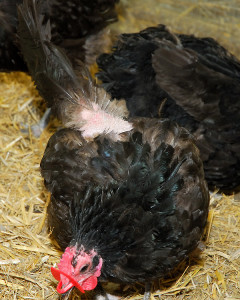
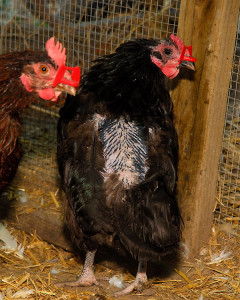
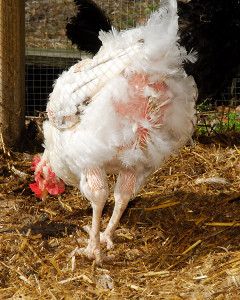
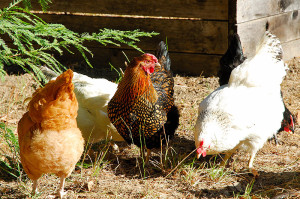







Your hens look so much better. Good for you for working through this.
And Bob! He looks like he owns the place. I know he’s a nuisance, but he’s such a beauty. I’ve only seen two wild bobcats in my life, and I treasure both of those experiences.
I love seeing Bob. He can be a nuisance, and laying in front of the car he looks like he’s very entitled, and he is, he was here before us. It’s pretty special having a ‘resident’ Bobcat here. We’ve just come to an understanding. If we don’t leave the hens out, he won’t eat our girls! 😛
This is quite an interesting article. We have dozen hens, 6 pairs of different varieties, no roosters, but we do have a pecking problem. Our white leghorn was pecked bloody raw on her tail end, much like your rooster, so we housed her in the dog travel crate for about two weeks until her pin feathers began to grow back. She was reintroduced to the flock with a purple goop on her bare spot that was supposed to help it heal and keep the other hens from pecking her. And it worked. but we still have the pecking problem; the purple goop does not seem to work on the other hens. Where did you find the peepers? We may have to try them.
The purple goop, I know it well (and stains like craaaaaazy). Blue-Kote is great for disguising small wounds, and making it so the hens can’t see blood. I used it on the Delaware above when her elbows were pecked raw and bleeding. She looked ridiculous as her feathers were naturally white, but it did prevent a little blood from triggering a blood-lust pecking frenzy. Unfortunately though it doesn’t stop the pecking.
There is a product called ‘Hot Pick’ that some hens find distasteful, but again, it doesn’t prevent the behavior in determined hens. It’s a spicy spray-on product. The trouble is, when the hen preens her own feathers she gets a mouthful too, but it may be helpful in an emergency (I just wouldn’t spray it on an open wound).
So far I’m loving the peepers. I ordered mine from Randall Burkey online (there are links to four online suppliers at the very end of the post, highlighted in blue). Randall Burkey sells them in a bag of 100, but considering shipping cost I figured it didn’t hurt to have them on hand, and if any got lost along the way, I’d have plenty of replacements.
The pliers are expensive, and honestly, I think they’d make it almost harder to get the peepers on. I’d try without them. Just soak them in really hot water for a few minutes first to get the plastic to soften up. Having a helper hold the bird helps a lot too.
It’s frustrating living with hens that pick on each other. I hope the peepers work out for you, just be sure to order the pinless variety, as some of the vendors sell both kinds. These are the ones I ordered for my girls:
http://www.randallburkey.com/PIN-LESS-PEEPERS-100-PKG/productinfo/10097/
As you can see, they were red, not yellow, but the girls don’t care 😉 Good luck!
Wow, it seems there’s just never a dull moment there at CV! Beautiful or not, those bobcats would keep me nervous if I knew they were ever present. I did find out from a neighbor that we do have coyotes in our area, though I haven’t seen them (yet). I love the new bling and hope it keeps the girls from their pecking!
I’ve had a few intense moments with Bob, where he’ll be harassing the girls, or standing on the coop roof and refuse to get down as I approach. For the most part though, we’re content to just give each other space. It’s not like he’s going to starve around here, not with all the squirrels, voles, gophers, and rabbits on this property. He just occasionally seems to insist that he expected a whole chicken-dinner-to-go…and of course he almost succeeded with Zilla last year. 😉
I’m actually more afraid of the coyotes. Just one, and they usually run away, but we’ve had a pack here trying to hunt down our Tom turkey in broad daylight, and I had a tough time convincing them to back off. As a pack their whole mentality is different. Thugs.
Maybe Bob is now afraid of the peeper clad hens! They kinda look a little like small super heroes in their red spectacles. But seriously, do you think the hens could have been feather picking themselves too? It becomes itchy for them and only encourages more feather picking I think. At least it does in Cockatoos.
Maybe they need capes too? 😉 I’ve never seen the hens pull their own feathers. With the peepers on, the girls can still preen, and their feathers are growing back for the first time in months. If they were self-plucking due to discomfort, I don’t think it would stop just because of the peepers, and honestly it’s not a behavior I’ve ever seen in chickens. Also, about half the girls were missing the feathers on the tops of their heads, and all down their necks, including the back of the neck, so I know they can’t reach those.
I agree, with exotic birds, self-plucking is quite common, and often a neurotic behavioral problem. We did have a friend some years ago with sulfur-crested cockatoo who plucked himself silly though. When I first saw him he had his back to me, and I said ‘what a beautiful bird’. Then when he turned around, and I almost fell over laughing (I didn’t mean to, but he looked ridiculous, like a half plucked turkey). Any feathers he could reach, were gone. They found out, quite accidentally, that he only plucked his feathers when he was OUTSIDE of his cage. He was scared of the big wide world. He was caged for 3 weeks while they were on vacation, and all his feathers started to grow back, go figure!
Clare, Bob looks entirely too comfy at Curbstone Valley. But boy is he a beauty. I keep leaving the garden gate open in hopes that a fox moves in~I wouldn’t mind a predator visiting the mice, chipmunks and voles. I do hope the peepers work and the pecking stops. Gail
He is a beauty, and borderline chunky! He’s not getting our girls, but he’s clearly well fed. I dread to think how bad our voles and gophers would be if he wasn’t here! 😉
I must confess your first picture made me think you had some new hens kitted out in battle mode – though I thought thered helmets with visors were natural 🙂
Looks like you have been having a traumatic time (and the hens too). Must be difficult to fathom out how a hen thinks. Glad things are looking up.
Bob looks to have lots of confidence in himself – what a show off!
I gave up trying to figure out how a hen thinks some time ago 😉 I’m always amazed how mean they can be to each other. Although our older hens were never this much trouble.
Love those new sunglasses on the girls! I have never had chickens, but have still heard of their pecking and pulling tendencies. Good job on solving this problem!
The term ‘pecking order’ came about for a reason, and was no doubt coined by a chicken farmer 😛 There’s no question who is on the bottom of the pecking order in this coop!
I do love Bob but I know he is a problem. Those peepers are so cool. I have never heard of these. It looks like the hens have glasses…
Sometimes I’m amazed anyone can truly free-range chickens. I swear some days I’m convinced the whole concept is a myth 😛 Ground predators, aerial predators, some days it’s endless here. Although that is what I get for trying to raise chickens in the middle of a thriving, balanced, wildlife habitat!
Interesting methods we have in this day. Chicknology I suppose.
Hmmm…does that make me a Chickenologist? 😉
Wow, I’m just amazed how much can go wrong with animals. I mean, I should have know. Just looking at how many plants I throw out every year because I misunderstood what they wanted in life…
Love the photos with the peepers ;->
No kidding! Flock dynamics are definitely varied. We have one set of hens in the orchard that all get on great together. This group of Divas though are definitely more high maintenance! 😉
Fascinating! I’m glad you’ve found a good solution! Hopefully this will break them of the habit!
I hope so too, I hate seeing the girls look so raggedy. They’re quite beautiful when they’re fully feathered.
Sounds like daycare with bullies and their victims. Great that you found a solution!
Sly bullies at that! It’s been difficult figuring out who the main aggressors are, as some of the bullies seem to pick on each other too! There’s no question who the victims are though. So glad I’m not a chicken 😉
Clare, Your blog posts are a constant source of amazement and education for me. So many potential sources of drama in on your farm! I laughed out loud at the thought of the hens being terrorized by the hanging cabbage heads. Is this similar to the way the the heads of executed prisoners used to be displayed on spikes to keep the rest of the population in line?
The cabbage heads were funny. They’ll eat cabbage on the ground, but had a look of “that cabbage’s eyes are following us around the room” when we hung it from the run roof 😉 After three days we decided the cabbage really wasn’t going to work, and cut it loose. It was devoured by the next day!
Have spent quite a bit of time trying to catch up on all the doings at the farm. Ugh, those poor, beleaguered chickens! They sure do pick on each other.
You guys are BEYOND busy. Makes me feel ashamed. I am working the soil here, adding straw, mulching, picking lots of fruit, and enjoying every second of California sunshine.
Thanks for all your wonderful postings.
One gardener to another,
Sharon Lovejoy Writes from Sunflower House and a Little Green Island
The good news is the girls are really starting to feather in, and their spectacles have stayed on! Wish I’d tried this sooner!
We have been a bit hectic here lately. Sometimes I wonder what it is I do all day that keeps me so busy! Much of it though is that good-sort-of-busy. I’ve been trying to make the most of this gorgeous sunshine we’ve had the last few weeks too. The ground is still damp from the last rain, and perfect for digging in!